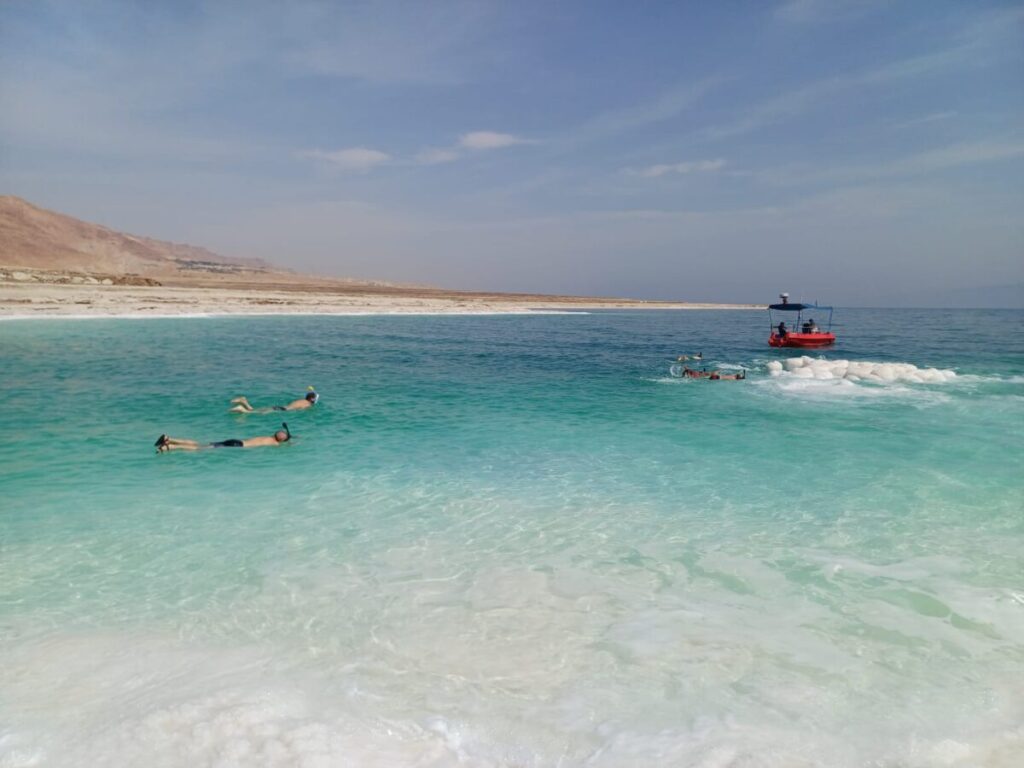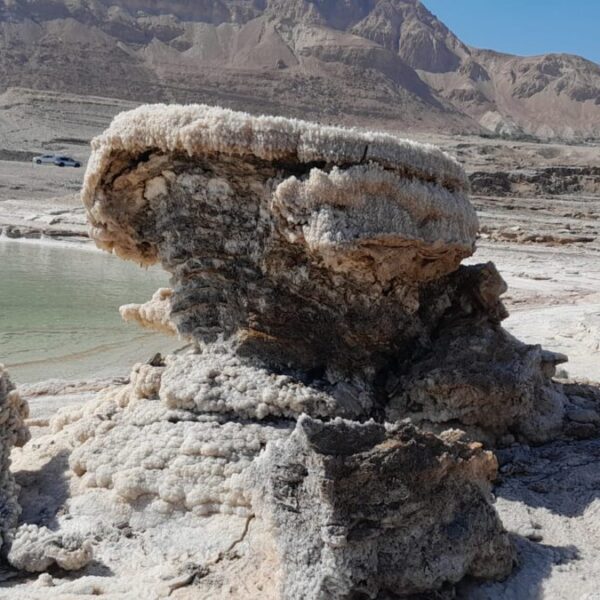Mystical symbol and unique natural wonder of the world, the Dead Sea is now in great danger. Since the 1960s, its level has been dropping by about one meter per year, and it has now lost nearly one-third of its surface area. This results in serious geological and ecological consequences, illustrated by lunar landscapes of salt, mud, and sinkholes.
The main cause of this retreat of the Dead Sea is the over-exploitation of the Jordan River. Once abundantly feeding the Dead Sea, it is now diverted by more than 90% by Israel, Jordan, Syria, and the Palestinian territories for irrigation and drinking water consumption. Deprived of this vital supply, the sea can only evaporate under the effects of the desert climate.
Over-exploitation and mining industry
In addition, there is the mining industry, particularly the extraction of minerals such as potassium and magnesium. Large companies located around the sea use an accelerated evaporation system to recover natural resources. This causes an evaporation of about 300 million cubic meters per year and further exacerbates the decrease in water level.
“The diversion began in the 1960s when Israel built a dam to retain water for the country's use. Then, in the 1970s and 1980s, the Syrians built more than 40 dams on the Yarmouk River. Thus, all the freshwater that should reach the Dead Sea is largely contained. The Israelis extract about 450 million cubic meters per year, the Syrians about 400, and the Jordanians around 300. In total, more than one billion m³ of freshwater is missing each year due to the water consumption of these three countries,” explains Professor Nadav Lensky, director of the Dead Sea Observatory, Geological Survey of Israel.
Population growth is also a factor: the population has increased, and consequently, the water needs have also risen.
Between fascination and paradox: the salty landscapes of the Dead Sea
One of the great paradoxes related to the drop in water level is that it creates some of the most iconic and appreciated landscapes for visitors. The salt formations that appear offer a fascinating spectacle.
“The most beautiful photos are those of the Dead Sea with salt, yet this visual phenomenon is closely linked to a process of environmental degradation. Indeed, when the level drops, the salt precipitates and form beautiful salt layers. If level continues to decline, more and more of these salt landscapes will appear. Whereas, if we will add water to the lake to stabilize its level, these salt layers will dissolve and disappear, and we will remain with mudy coastlines, instead of salty coasts. If you are worried that the level is dropping, and you plan to add water to the dead sea, then you should say goodbye to the salty landscapes” explains the professor.
“The geology of the region is very interesting. For example, when the level drops, salinity increases. The Dead Sea becomes so salty that in 1982, we began to observe deposits of halite (rock salt) in its waters,” he continues.
The sinkholes: a worrying phenomenon
Among the most spectacular consequences of the retreat of the Dead Sea is the appearance of sinkholes on the dried surfaces. These enormous ground collapses can swallow roads, buildings, or entire beaches. Their formation is linked to the dissolution of salt beneath the surface by freshwater aquifers, now more present due to the drop in sea level. In less than thirty years, more than 7,000 sinkholes have been recorded, transforming some areas into real crater fields.
Once the salt is dissolved, cavities form. The ground, now unstable, collapses suddenly. Some sinkholes reach several tens of meters in depth, posing serious risks to infrastructure and residents. Debates are emerging on how to stabilize the water level. However, these discussions face historical, environmental, and geopolitical considerations.
Proposed technical initiatives, such as adding water through pipelines, carry heavy consequences such as the risk of ecological imbalances. The massive injection of water, particularly seawater or desalinated water, could alter the unique chemical composition of the Dead Sea, affecting its salinity and microbial biodiversity. Uncontrolled chemical reactions could also lead to the appearance of gypsum or red algae. From a geopolitical perspective, projects involving Jordan also pose problems: Nothing can be implemented without the approval or direct supervision of Jordan. Any infrastructure for piping or any transfer of water, materials, or information must go through their authority. Jordan has the initiative and decision-making power, even for elements that could affect Israeli territory or interests. Israel finds itself in a position of dependence, without the ability to act independently.
Some blame industrial sites for the drop in water level. However, their impact is limited compared to structural and deep causes. “Even if we closed the factories today, instead of dropping by one meter ten per year, the level of the Dead Sea would lose 85 cm. This is not an option that solves the problems; it actually creates new ones. What we want is to make the salt beaches accessible to the public,” declares Nadav.
Projects, but few solutions
Several projects have been considered to try to save the Dead Sea. The most ambitious is the Red Sea - Dead Sea canal, a colossal project of about 200 km that aims to divert water from the Red Sea to supply the Dead Sea while generating electricity through hydroelectric plants. This tripartite project, supported by Jordan, Israel, and the Palestinian Authority, was signed in 2013, with the support of the World Bank. However, it raises environmental concerns, particularly the risk of disrupting the unique chemical balance of the Dead Sea. Today, Israel has withdrawn from the project deemed too costly and ecologically risky, not to mention the political tensions that have arisen between the two countries. Jordan is independently pursuing plans to build a desalination plant in Aqaba and transport water to Amman.
Despite numerous projects to “save the Dead Sea,” no solution seems to match the complexity of the problem. Each option has its limits, costs, and contradictions. “In trying to address the retreat of the Dead Sea, new difficulties arise,” observes Nadav Lensky. “The question is whether they are smaller or larger than the initial problem.”

Cover photo: “The most beautiful photos are those of the Dead Sea with salt" © Nadav Lensky
